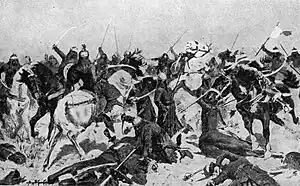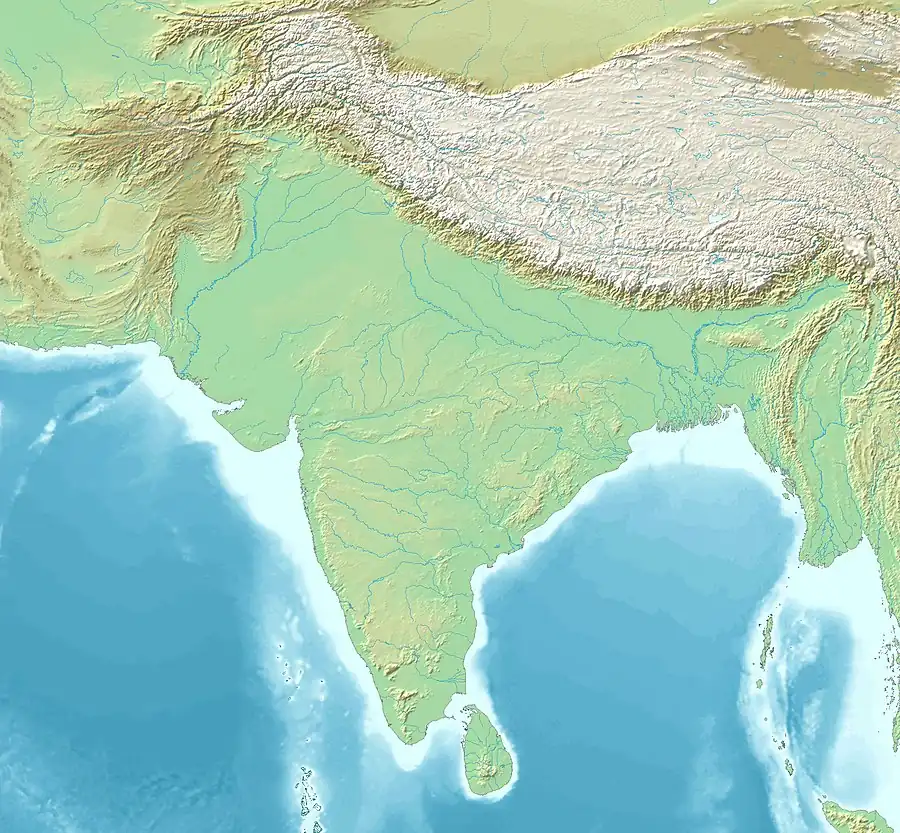Second Battle of Tarain
The Second Battle of Tarain was fought in 1192 between the Ghurid forces of Muhammad Ghuri and the Rajput Confederacy of Prithviraj Chauhan. It took place near Tarain (modern Taraori), which is 110 kilometres (68 mi), north of Delhi. The battle ended in a decisive victory for the invading Ghurids and their successful penetration in north Indian plain.
| Second Battle of Tarain | |||||||||
|---|---|---|---|---|---|---|---|---|---|
| Part of Indian campaigns of Muhammad of Ghor | |||||||||
 "The last stand of Rajputs" by Hutchinson & co | |||||||||
| |||||||||
| Belligerents | |||||||||
| Ghurid Empire | Rajput Confederacy | ||||||||
| Commanders and leaders | |||||||||
|
Muhammad Ghuri Qutubuddin Aibak Bahauddin Tughril Husain Kharmil Taj al-Din Yildiz Nasir ad-Din Qabacha Muhammad bin Mahmud Khalji Mukalba Kharbak[1] |
Prithviraj Chauhan (POW) Govind Rai † Samantsingh † [2] Badamsa Rawal Bhola Vijayraj †[3] Harapal Parmar † Rajpal Parmar † Rana Motishvara †[4] | ||||||||
| Strength | |||||||||
| 120,000 (according to Minhaj)[5][6] | 300,000 (likely exaggeration) [lower-alpha 1][8][lower-alpha 2] | ||||||||
| Casualties and losses | |||||||||
| Unknown | 100,000 according to Hasan Nizami[9] | ||||||||
 Tarain Location of the Second Battle of Tarain | |||||||||
The battle is regarded as a watershed event in Medieval India history as it led to the destruction of Rajput powers for a while and laid the foundation of Muslim rule in North India, which led to the establishment of Delhi Sultanate.[10][11]
Background
Prithviraj Chauhan's forces had defeated the Ghurids at the First Battle of Tarain in 1191. The Ghurid king Mu'izz al-Din, who was seriously injured in the battle, returned to Ghazni, and made preparations to avenge his defeat.
Historians generally date the second battle of Tarain to 1192, although there is a possibility that it happened in late 1191.[12]
Size of the forces
According to the 16th-17th century writer Firishta, the battle, "the Chauhan army consisted of 3,000 elephants, 300,000 cavalry and infantry", which is considered an exaggeration by modern historians. According to Satish Chandra the figures were exaggerated in order to "emphasise the challenge faced by Muizzuddin and the scale of his victory".[7] Kaushik Roy similarly notes that Muslim chroniclers regularly exaggerated Hindu military strength to glorify the Muslim kings, and 300,000 was probably the theoretical number that could potentially be mobilized by all the Rajput kingdoms at the time.[6]
According to Indian sources like Hammir Mahakavya and Prithviraj Raso, Chahamana army was simultaneously engaged on multiple fronts and Prithviraj had only a part of his army at the battlefield. His other army was about to reach Prithviraj but the fate was already decided in favour of Muizuddin.[13]
According to Minhaj-i-Siraj, Mu'izz al-Din brought 120,000 fully armored men to battle,[5] He personally commanded an elite cavalry force of 40,000 men. According to historian Kaushik Roy, while the real strength of the armies is not certain, it can be speculated that Prithviraj's army was numerically superior.[6]
Battle
The battle occurred in the same field as the first one. Knowing the Chahamana forces were well-disciplined, the Ghurids did not want to engage in melee combat with them. Instead the Ghurids army was formed into five units, and four units were sent to attack the enemy flanks and rear.[14]
According to Minhaj, Mu'izz ad-Din directed a light cavalry force of 10,000 mounted archers, divided into four divisions, to surround the Chahamana forces on the four sides.[15] He instructed these soldiers not to engage in combat when the enemy advanced to attack, and instead feign retreat in order to exhaust the Chahamana elephants, horses, and infantry.[16]
In hopes of causing a break in the enemy lines, Mu'izz al-Din ordered his fifth unit to feign retreat. The Chahamana forces charged the fleeing Ghurid unit, as the Ghurids expected. The Ghurids then sent a fresh cavalry unit of 12,000 and they managed to throw back the enemy advance. The remaining Ghurid forces then attacked and the Chahamana troops fled in panic.[14] According to Minhaj, Mu'izz ad-Din's strategy "exhausted and wearied the unbelievers", ultimately resulting in a "victory to Islam".[16]
Aftermath
Minhaj states that Prithviraj ("Rae Pithora") dismounted from his elephant, and fled from the battlefield on a horse. He was, however, captured in the neighbourhood of Sursuti, and later "dispatched to hell".[16] Most medieval sources state that Prithviraj was taken to the Chahamana capital Ajmer, where Muhammad planned to reinstate him as a Ghurid vassal. Sometime later, Prithviraj rebelled against Muhammad, and was killed for 'treason'.[17]
The Ghurid forces subjugated the entire Chahamana territory of "Siwalikh"[16] (or Sawalakh, that is, Sapadalaksha).[18] The Ghurids then appointed his son Govindaraja IV on the throne of Ajmer as their vassal. Prithviraj's younger brother Hariraja dethroned Govindaraja, and recaptured a part of his ancestral kingdom, but was later defeated by the Ghurid general Qutb al-Din Aibak.[19] The Ghurids subsequently defeated another powerful king - Jayachandra of Gahadavala dynasty - at the Battle of Chandawar, and conquered parts of northern India as far as Bengal.[14]
Notes
- considered a gross exaggeration by modern historians, this was probably the theoretical strength that could be engaged by all the Rajput polities in India rather than the forces actually deployed on the battlefield.[7]
- According to the historically unreliable Prithviraj Raso, Prithviraja's army numbered only eighty three thousands for the final battle. Historian Kaushik Roy estimated that the Rajput army was numerically superior to the Ghurid army
References
- K. A. Nizami 1992, p. 162, 172:"Muizzuddin's army had four veteran war-lords of Ghazni-experienced, determined and desterous--Kharbak, Kharmil, Ilah, Mukalba. Each had under his command a huge army, Besides them there were--Tajuddin Yalduz, Qubacha and Aibek. The Sultan started from Ghazni in 587/1191, reached Tarain in 588/1191-92 and pitched his tent at the same place where he had suffered a serious defeat a year before. According to Ferishta, 150 Rajput rais had come to the feld with Rai Pithora, determined to crush or be crushed :-Bakhtiyar did not belong to an obscure family. His uncle, Muhammad bin Mahmud, had fought against Prithvi Rai at the second battle of Tarain"
- Rima Hooja 2006, p. 349.
- K. A. Nizami 1992, p. 164:"The details supplied by Isami about the actual disposition of the armies are more interesting. According to him Govìnd Rai was the mugaddam of the Rajput forces. He fought in advance of Pithoras army; Pithora fought in the centre. The left wing of Pithora's army was under Bhola, who was the wazir; the right wing was led by Badamsa Rawal"
- R. V. Somani 1981, p. 62: "The Paramara Rajputs held Badlu, Phalodi etc. under them. Parmar Harpapal and Rajpal of Badlu gave away their lives in the battlefield of Tarain in 1192 A.D...Rana Motishvara and his son Vijayraj gave their lives in the second battle of Tarain"
- Satish Chandra 2006, p. 25.
- Kaushik Roy 2014, pp. 22–23.
- Satish Chandra 2006, pp. 25–26.
- Kaushik Roy 2014, p. 23:"We can speculated that the Rajput Army was numerically superior to the Ghorid army
- Dasharatha Sharma 1959, p. 86: "Prithviraja was asleep, the Rajput soldiers were just moving out for their daily ablutions and other morning duties. Having thus taken by surprise, the Rajputs could not have escaped considerable losses, but they could still have drawn themselves into fighting order, if the well thought out strategy of Muhammad Ghori had not lured and drawn them out into an unsystematic and ill-advised pursuit. The Rajputs were completely routed, losing about 100,000 men according to Hasan Nizami.
- Sugata Bose; Ayesha Jalal (2004). Modern South Asia: History, Culture, Political Economy. Psychology Press. p. 21. ISBN 978-0-415-30786-4.
It was a similar combination of political and economic imperatives which led Muhmmad Ghuri, a Turk, to invade India a century and half later in 1192. His defeat of Prithviraj Chauhan, a Rajput chieftain, in the strategic battle of Tarain in northern India paved the way for the establishment of first Muslim sultante
- Rima Hooja 2006, p. 458: "..Nevertheless, the battle, as far as the Rajput powers were concerned, was not so destructive as the battle of Tarain between Prithviraja III and Muizuddin Ghori. Though it weakened the power of the kingdom of Mewar and lowered its general prestige, it did not destroy the grip of the Sisodias over their kingdom, nor did it affect the social and economic conditions of life in the state"
- Cynthia Talbot 2015, p. 44.
- Singh, R. B. (1964). History of the Chāhamānas. Varanasi: N. Kishore. pp. 199–200.
- Spencer C. Tucker 2009, p. 263.
- Cynthia Talbot 2015, p. 47.
- Cynthia Talbot 2015, p. 48.
- Dasharatha Sharma 1959, p. 87.
- Cynthia Talbot 2015, p. 33.
- Dasharatha Sharma 1959, pp. 100–01.
Bibliography
- Cynthia Talbot (2015). The Last Hindu Emperor: Prithviraj Cauhan and the Indian Past, 1200–2000. Cambridge University Press. ISBN 9781107118560.
- Dasharatha Sharma (1959). Early Chauhān Dynasties. S. Chand / Motilal Banarsidass. ISBN 9780842606189.
- Kaushik Roy (2004). India's Historic Battles: From Alexander the Great to Kargil. Orient Longman.
- K. A. Nizami (1992) [1970]. "Foundation of the Delhi Sultanat". In Mohammad Habib; Khaliq Ahmad Nizami (eds.). A Comprehensive History of India: The Delhi Sultanat (A.D. 1206-1526). Vol. 5 (Second ed.). The Indian History Congress / People's Publishing House. OCLC 31870180.
- Kaushik Roy (2014). Military Transition in Early Modern Asia, 1400-1750: Cavalry, Guns, Government and Ships. Bloomsbury. ISBN 978-1-78093-800-4.
- Rima Hooja (2006). A History of Rajasthan. Rajasthan. ISBN 9788129115010.
{{cite book}}: CS1 maint: location missing publisher (link) - R. V. Somani (1981). Prithviraj Chauhan and his times. Publication Scheme. ISBN 9788185263021.
- Satish Chandra (2006). Medieval India: From Sultanat to the Mughals-Delhi Sultanat (1206-1526). Har-Anand. ISBN 978-81-241-1064-5.
- Spencer C. Tucker (2009). A Global Chronology of Conflict: From the Ancient World to the Modern Middle East. ABC-CLIO. ISBN 978-1-85109-672-5.